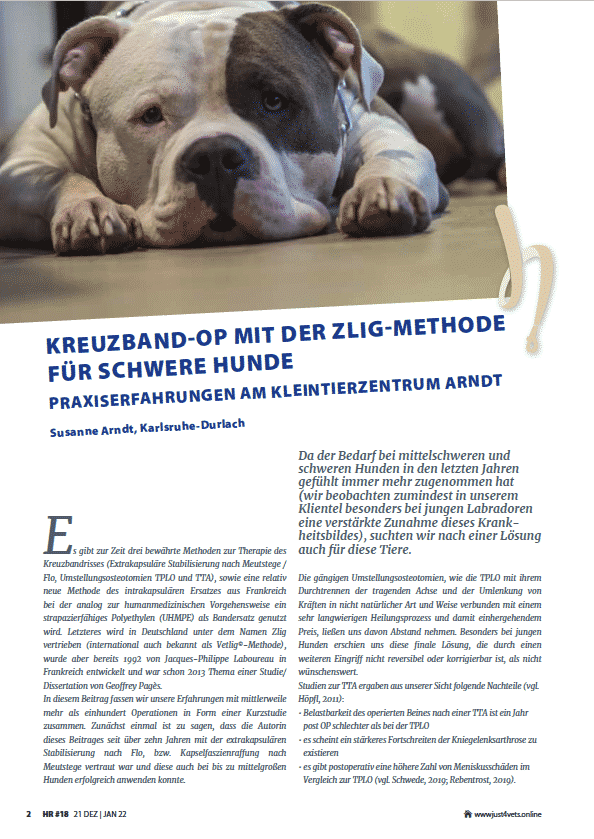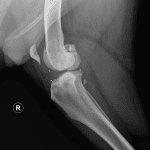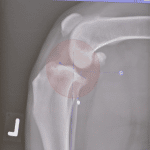The Zlig (formerly: VetLig) / Petlig method
Zlig (formerly: VetLig) - an intracapsular ligament replacement
This method has been used on humans for 25 years. The body's own or artificial material (tendons, parts of the patellar ligament, fascia) is used as a ligament replacement in place of the torn cruciate ligament.
This method had not been effective for dogs for a long time. Due to the insufficiently controllable stress on the knee joints in dogs after surgery, the ligament replacement tore again in many cases.
After much preparatory work by Dr. Jacques.Pillipe Laboureau developed a synthetic band for intra-articular cruciate ligament replacement in small animals.
Using a tunnel technique, the Zlig is used as a total replacement for the cruciate ligament. The braided extra-articular parts of the ligaments are anchored in femoral and tibial bone tunnels by cannulated titanium interference screws.
With the development of new materials in medical technology, it is now possible to give dogs / cats a surgical method that is considered state of the art for humans because it best replicates the animal's natural anatomy and, in contrast to TPLO / TTA, does not have any stressful changes to the bones.
After much preparatory work by Dr. Jacques.Pillipe Laboureau developed a synthetic band for intra-articular cruciate ligament replacement in small animals.
Using a tunnel technique, the Zlig is used as a total replacement for the cruciate ligament. The braided extra-articular parts of the ligaments are anchored in femoral and tibial bone tunnels by cannulated titanium interference screws.
This technique does not cause irreversible damage.
Advantages:
✓ Can also be used with very heavy dogs >70kg
✓ Replicating the natural anatomy without serious interference with the bone structure
✓ The patient's hind leg can be used again very quickly (!) after the operation without any risks (although we recommend resting on a leash in the first few weeks)
✓ Lower costs than TPLO or TTA when you look at the total effort including follow-up treatment and physiotherapy
✓ especially at young animals This method does not prevent you from having to use Zlig or TPLO / TTA again later - the latter, however, are one-off and final and if problems arise again, in the worst case scenario it means amputation
✓ at old animals and bilateral ligamentous lesionss can be done in one operation with the one we developed Petlig Method ® (only one-time risk of anesthesia; parallel operation of both knees by two surgeons = shortened operation time, etc.) both torn ligaments are treated and the animal is recovered promptly (here: Example of a 14 year old dog two days after surgery) is resilient again and has a better quality of life again
Disadvantage:
X higher costs than capsular fascia tightening according to Meutstege or lateral suture restraint
FAQs about the Zlig (formerly: VetLig) method
Is Zlig (formerly: VetLig) a new method of cruciate ligament surgery in dogs/cats?
Yes and no. The basic procedure has been used in humans for around 25 years. In France, this method for animals has existed for more than ten years - see studies below. It is therefore newer than TPLO / TTA in the veterinary field, but mature enough to have good experience over a longer period of time. There is often outdated information that artificial cruciate ligament replacement does not work in animals. This is definitely not the case (see studies below and our own experiences from over 150 surgeries contradict this statement - see our article at Dog Rounds).
How often do you generally use this variant?
We now operate several times a week using this method. The operation is carried out by a permanent, experienced surgical team under the direction of Medical Director Susanne Arndt. one of the leading small animal practices in southern Germany with over 150 operations
Does this variant also make sense for active dogs or can he run and play again after the closed season just as inexperienced as before?
The VetLig could even be used for cats that require enormous forces in their hind limbs. The ligament that we use in a dog has a tensile strength of up to 9000 Newtons; in comparison, the human anterior cruciate ligament can withstand up to 2500 Newtons before it tears. This means that after complete convalescence, unrestricted loading is possible.
What complications could arise? Is the replacement strap made to last a dog’s life?
It is relatively unlikely that the replacement band will tear; its architecture is designed to withstand friction and shear forces for a lifetime. If there is still a problem with an implant or the screws, it would even be possible to use the same technique again or any other methodology.
Our study of 67 Zlig surgeries compared with TPLO, TTA & TTA Rapid
Simply click on the image and download the complete article or view it online in the flipbook below:

How the Zlig method works
Results of the cruciate ligament replacement method according to Zlig (formerly: VetLig) from our practice
Case study 1 - older dog
Case study 3 - bilateral cruciate ligament surgery
Case study 4 - bilateral cruciate ligament surgery
Case study 2 - younger dog
Inquiry
You can use the following form to make a qualified, non-binding request for cruciate ligament surgery. Ms. Arndt will then be happy to contact you by telephone promptly for further advice - please let us know your preferred callback times:
Further studies on the Zlig (formerly: Vetlig) method
An extensive clinical study between 2012 and 2021 (here) shows good to excellent results in 98% of cases and is therefore currently the most modern and gentlest treatment method for heavy animals.
VetLig Thèse-Geoffrey-PAGES 15 cases 2013






